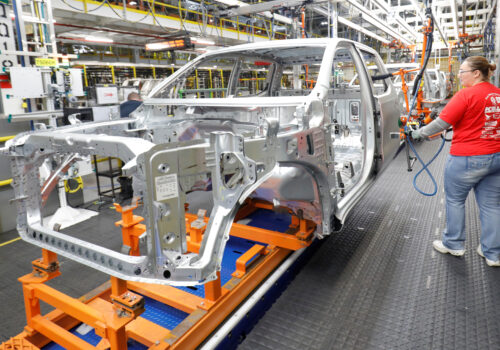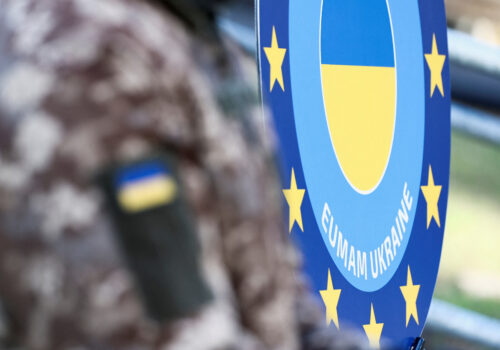Foreword: A new agenda for the next four years of US-EU relations
This essay is part of the report “Transatlantic horizons: A collaborative US-EU policy agenda for 2025 and beyond,” which outlines an agenda for common action for the next US administration and European Commission.
“Americans were the best Europeans,” quipped German Chancellor Konrad Adenauer to Secretary of State Dean Acheson in 1949. He meant that the United States supported a strong, free, and united Europe—not one divided, strife-ridden, and poor. Both men, venerated for their visions of a peaceful, prosperous, and free world order following some of the most violent years in modern history, were among the architects of the modern transatlantic relationship. To achieve such goals in the face of would-be autocrats would require an active US role in the world, arm-in-arm with allies and partners in Europe and beyond. Americans would indeed have to be good Europeans, and so it turned out for nearly eighty successful years of transatlantic security, general peace, and prosperity.
Today, autocrats again are on the march, and the free world is again under threat. Vladimir Putin’s Russia seeks to conquer Ukraine to reconstitute Moscow’s empire and is running sabotage operations inside European Union (EU) and NATO countries. China has been intimidating its neighbors, claiming control over large parts of the Pacific, and may be planning to go further against Taiwan. Iran fans flames of violence in the Middle East, exporting terror and exploiting conflicts. These and other autocrats work together, sharing intelligence, military hardware and technology, helping each other evade sanctions, enabling corruption, and generally protecting each other.
At the same time, the United States, Europe, and other responsible powers must also grapple with a range of challenges, including still-unchecked climate change, new technologies with all their productive and disruptive potential, and the need to modernize trade and investment rules to realize the potential for growing and shared prosperity while limiting the ability of rapacious powers to game the system.
The United States and Europe have not been idle, and the US-EU partnership has never been as strong, as expansive, or as robust as it is today. However, the challenges have become stronger and more widespread. The United States and Europe have backed Ukraine in its fight for survival, preventing a Russian victory, but no clear path to success is yet apparent. The United States and key friends and allies in Europe and Asia are working to discourage Chinese adventurism, but China’s power to threaten and perhaps do worse seems to be growing. Global efforts to reduce carbon emissions and move the world’s energy mix in a green direction are gaining strength but have not bent the curve away from climate catastrophe. The United States and Europe have started speaking of new practices for the international economic system, such as “friendshoring,” but not yet spelled out what this means.
Amid these challenges, European and US leaders face inward-looking, isolationist, nativist, and populist politics; twenty-first century versions of some of the West’s worst political traditions are back in many countries. Without answers to the concerns that frustrate millions of US and European citizens, a perceived lack of opportunity high among them, political support for US and European leadership to maintain, adapt, and grow an open and fair international commons, and perhaps for democracy itself, may sag. The post-Cold War vision of a world united by common values and a rules-based order seems beset on many sides.
The problems are great, but so are the assets to deal with them. Together, the United States, Europe, and their closest partners still constitute the core of the liberal world order—aka the free world. They have the strength and resilience, if applied well, to master today’s tasks. Democracies, though often messy, are, as a rule, in better shape than they sound, while autocracies are less so. During long stretches of the Cold War, the United States and Europe convinced themselves that they were in decline while adapting themselves to the challenges of those days, setting the stage for a success that was as unexpected as it was profound. We did it then, and we can do so today.
This year marks a critical time for this democratic effort. Elections on both sides of the Atlantic will usher in new governments, administrations, and commissions for some 785 million people. No fewer than fourteen countries inside the transatlantic alliance have held or will hold elections this year.1Elections in 2024 at the federal or supernational level include: Austria (parliamentary elections), Belgium (federal elections), Bulgaria (parliamentary elections twice), Croatia (parliamentary and presidential elections), Finland (presidential elections), France (parliamentary elections), Hungary (presidential elections), Lithuania (parliamentary and presidential elections), North Macedonia (parliamentary and presidential elections), Portugal (parliamentary elections), Romania (parliamentary and presidential elections), Slovakia (presidential elections), the United Kingdom (parliamentary elections), the European Union (European parliamentary elections), and the United States (presidential elections). Further, the June elections for the European Parliament have ushered in a new five-year mandate for the European Commission this fall—with Ursula von der Leyen spearheading a more geopolitical EU. Meanwhile, Americans will vote for a new president. Transition and turnover offer a chance for reflections on what’s working and a chance to adapt what’s not.
This series of essays attempts to outline an agenda for common US-EU action to meet today’s challenges and set a productive vision for transatlantic relations for years to come. It identifies the issues policymakers must tackle and presents actionable recommendations for the next US administration and European Commission. The topics are varied, highlighting the breadth and depth of the US-EU relationship. It is worthy of continued investment.
The analysis and recommendations are nonpartisan, but they are driven by the Atlantic Council’s conviction that we are stronger together. From the other side of the world to each other’s backyards and into cyberspace, Washington and Brussels need each other.
The essays are ambitious in vision but not naïve. Cooperation between the United States and Europe is not always a given. Frustrations in some areas should not be ignored, and competition in others should be embraced. The transatlantic partnership, powered by the US-EU relationship, is a geopolitical necessity.
Daniel Fried is the Weiser Family distinguished fellow at the Atlantic Council, former US ambassador to Poland, and former US assistant secretary of state for Europe.
Jörn Fleck is the senior director of the Atlantic Council’s Europe Center.
read more essays

The Europe Center promotes leadership, strategies, and analysis to ensure a strong, ambitious, and forward-looking transatlantic relationship.
Image: People walk past the fountain outside the Billie Jean King National Tennis Centre during the US Open tennis tournament in New York, September 4, 2010. REUTERS/Shannon Stapleton (UNITED STATES - Tags: SPORT TENNIS SOCIETY)


